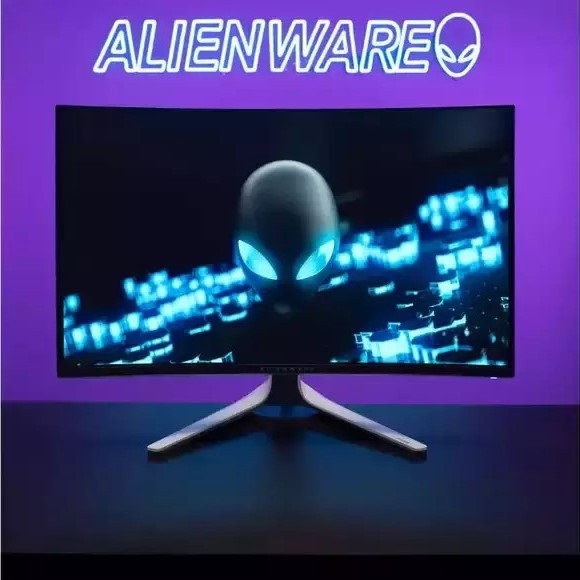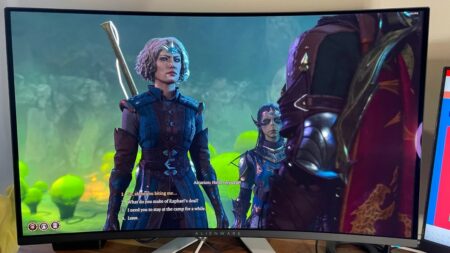CONS
ALIENWARE AW3225QF 4K QD-OLED SPECS
| Panel Size (Corner-to-Corner) |
32 inches |
| Native Resolution |
3840 by 2160 |
| Aspect Ratio |
16:9 |
OLED technology has undoubtedly made a name for itself in the realm of screen technology. However, when it comes to gaming monitors, we have primarily witnessed its presence in two size categories. On one hand, we have compact 27-inch models like the Corsair Xeneon 27QHD240 OLED, while on the other hand, we have the larger 40- and 50-inchers such as the LG 45 UltraGear OLED Curved Gaming Monitor. Breaking the mold and targeting the middle ground is Alienware’s latest offering. Unveiled at CES 2024, the Alienware AW3225QF ($1,199) is a 32-inch curved 4K QD-OLED monitor that boasts an impressive screen and an enhanced refresh rate. With its remarkable features, it is poised to be one of the top gaming monitors in 2024, deserving of the prestigious Editors’ Choice award.
Bringing 4K to the Midsize OLED Market
Alienware has previously experimented with OLED monitors in this size category. Last year, the Alienware 34 Curved QD-OLED Gaming Monitor was one of our top picks. The main distinction with the AW3225QF is its 4K resolution, making it the first of its kind in the world. Previous OLED models did not reach this resolution, sticking to the more common QHD resolution (2,560 by 1,440 pixels) or the ultrawide equivalent of 5,120 by 1,440 pixels. This gaming monitor is the first to combine this size with such high resolution.
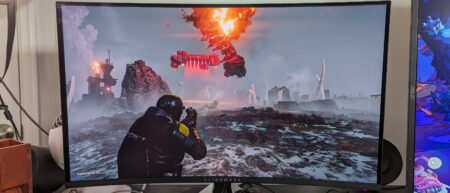
The 4K OLED monitor is designed with a gentle curve, which is even more subtle compared to the curve of the Alienware 34. Unlike most ultrawide monitors with a 1,800mm curve, the AW3225QF has a slight bend of 1,700mm (also referred to as 1700R). Although it is not as pronounced as the tighter-curved Corsair Xeneon Flex, this slight curve offers advantages such as minimized glare and enhanced depth in black levels. Additionally, it creates an illusion of a larger screen size than its actual dimensions.
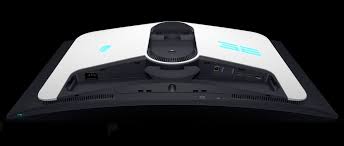
The monitor boasts an exquisite appearance, featuring striking black bezels that encase its display. When you flip the monitor, you will encounter the distinctive, loud Alienware design: a black-and-white color combination. On the rear side, you will also notice the Alienware logo and a prominent “32” (to remind you of the monitor’s size), both illuminated with customizable RGB lighting. While it undeniably exudes a bold gaming aesthetic, the back of the monitor serves a practical purpose as well, concealing a ventilation layer between the panel and rear housing to prevent overheating.
At the lower part of the monitor, there is a protective white panel that covers the port hub. This hub includes two HDMI 2.1 ports, two USB-A 3.2 ports, a USB-B upstream port, and a DisplayPort. Furthermore, additional USB-A and USB-C connectors are located beneath the monitor, nearer to the screen. By utilizing HDMI 2.1, you will be able to access enhanced frame rates on gaming consoles, along with variable refresh rates and the monitor’s low latency mode.
A DisplayPort 2.1 is not included, most likely because it has a limited range of applications. (This port is currently only compatible with AMD Radeon RX 7900 XT and RX 7900 XTX GPUs.) Additionally, there are no built-in speakers, but the monitor does offer eARC compatibility for connecting external Dolby Atmos speakers and soundbars.
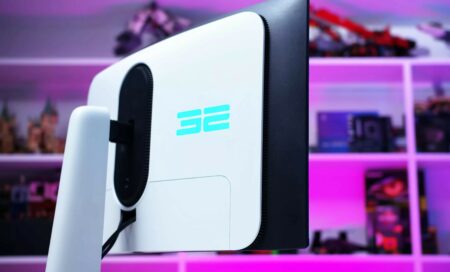
The dimensions of the monitor are 18.6 by 28.2 by 12 inches, with a weight of 13 pounds excluding the stand. It is slightly taller than the Lenovo Legion Y32p-30, making it a relatively compact size suitable for gamers with limited space who prefer a screen larger than 27 inches. The monitor is supported by a long white stand that offers tilt, swivel, and height adjustments, providing it with a remarkable level of flexibility.
In terms of gaming performance, the AW3225QF is truly impressive based on its specifications. The 240Hz refresh rate is likely to attract serious gamers, while the 4K resolution and 0.03ms response time will ensure they stay engaged. Additionally, OLED technology surpasses IPS, VA, and TN panels in various aspects such as power efficiency and color gamut support. OLED monitors excel in displaying “true blacks” by turning off black pixels to achieve zero-light areas and optimal contrast.
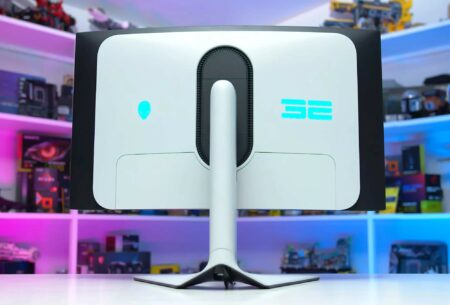
A new addition to this monitor is Dolby Vision HDR, which aims to enhance the HDR experience through enhancements in brightness, contrast, and color (further details on this can be found in the performance section below). Additionally, the VESA AdaptiveSync certification guarantees a smooth, tear-free gaming experience—and it is also compatible with Nvidia G-Sync.
Testing the Alienware AW3225QF: An All-Around Winner
Alienware’s stunning OLED display appears to be quite appealing, but how does it compare to other OLED monitors? To assess the monitor’s performance, we conducted tests on color gamut, brightness, color accuracy, and contrast ratio using Calman monitor calibration software, a Murideo Six-G signal generator, and a Klein K-10A colorimeter. Additionally, we subjected the monitor to various games to evaluate input lag and assess its practical performance.
Initially, we conducted a trial of the monitor using its default picture mode alongside an SDR signal. In this particular scenario, it exhibited an average brightness of merely 238 nits (candelas per square meter). Although this relatively diminished brightness might elicit some curiosity, it is occasionally favored, particularly for OLED monitors situated in dimly lit gaming spaces. This preference stems from the fact that OLED technology can uphold contrast with reduced brightness. However, it is worth noting that the diminished brightness may pose a challenge in rooms with more illumination or those illuminated by natural light.
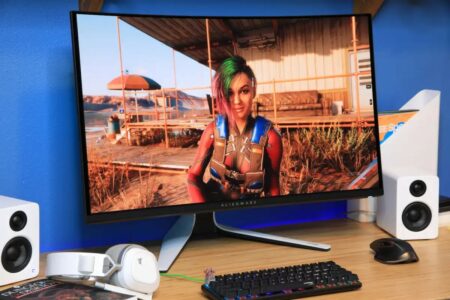
The monitor’s peak brightness in HDR is rated at 1,000 nits, a claim that was confirmed when we measured a peak brightness of 1,098 nits at a 2% sample size. While OLED displays tend to become brighter with smaller test patch sizes, it is unlikely that you will reach this level of brightness in typical gaming scenarios. There are only a few scenes in video games and movies where the highlight would reach such a measurement.
In terms of the monitor’s color gamut performance, the OLED panel remains impressive. It covered the entire sRGB color gamut, 95% of Adobe RGB, and 97% of DCI-P3 in our evaluations. These ratings are outstanding, only slightly lower than Samsung’s Odyssey OLED G9 and comparable to the Alienware 34. However, it is important to mention that we have not encountered an OLED display that fails to accurately reproduce colors. OLED panels consistently excel in this aspect.
Transitioning to HDR, we recorded a brightness of 483 nits when utilizing the Standard preset profile along with the HDR Peak 1000 setting. This slightly exceeds the monitor’s VESA DisplayHDR True Black 400 certification.
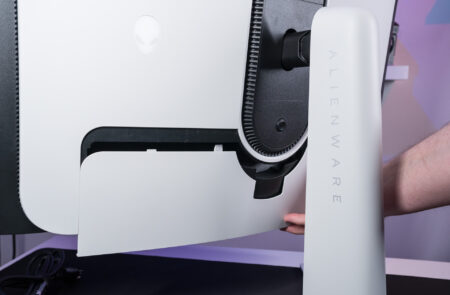
The monitor’s color accuracy deserves equal praise, with an outstanding Delta E measurement of 0.6. A higher Delta E indicates a greater deviation from the intended hue of colors. Ideally, a value below 1 is preferred, but it is rare for gaming monitors, especially when uncalibrated, to achieve such precision.
The contrast ratio is a crucial factor in determining the quality of a monitor’s picture. It represents the difference in brightness between the brightest white and darkest black that the monitor can display. Particularly in dark scenes during gaming, this contrast ratio plays a significant role. The AW3225QF has a peak contrast ratio of 1,000,000:1, although this number is unlikely to be observed in everyday usage. In our testing, we measured a contrast ratio of 254,391:1. OLED and mini LED panels have the potential to achieve much higher contrast ratios compared to other panel types, primarily due to the nature of their black pixels. In contrast, IPS panels typically aim for contrast ratios ranging from 1,000:1 to 3,000:1.
The Alienware AW3225QF boasts exceptional performance outcomes, making it an exquisite monitor. However, when it comes to response times – a crucial metric for dedicated gamers – how does it fare? To assess this, we utilize an HDFury Diva HDMI matrix to gauge the monitor’s input lag and engage in several games from our collection to detect any potential imperfections, such as screen tearing.
Initially, let’s discuss the input lag findings: Our measurements indicate a lag of less than 1 millisecond (ms). This is truly remarkable and essential for gamers seeking seamless performance in both first-person shooters and action games. However, it’s important to note that this figure may not hold much significance for those outside the dedicated esports community, who are unlikely to utilize this particular type of monitor. For competitive play, smaller monitors with even higher refresh rates, such as the Alienware 500Hz Gaming Monitor (AW2524H), are better suited.
When considering gaming on an OLED display, numerical data can only convey so much; witnessing the visuals firsthand is truly convincing. Rest assured, titles such as Returnal, Cyberpunk 2077: Phantom Liberty, Baldur’s Gate 3, and Halo: Infinite truly shine on this screen. Furthermore, the smooth gameplay of Counter-Strike 2 and Fortnite at elevated frame rates provides an exceptional experience, free from any distracting screen tearing.
Verdict: 2024 Already Has a Must-Buy Monitor
The ownership of an OLED gaming monitor, despite its magnificent features, comes with a hefty.Typically, such high prices are associated with larger or wider screens. However, although there are OLED monitors available at slightly lower prices, such as the Philips Evnia 34M2C8600 or the MSI MEG 342C QD-OLED, none of them can match the desired 4K resolution.
The year may have just begun, but the Alienware AW3225QF has ensured that it’s starting with a bang. A 4K resolution with a high refresh rate would make any gaming monitor a worthy contender for your hard-earned cash, but the addition of an OLED panel, an excellent color gamut, low input lag, and great HDR support seals the deal. The only downside? There’s no way around that high price. Still, if you’re in the enviable position to invest in an OLED gaming monitor, the Alienware AW3225QF 4K QD-OLED is the strongest candidate thus far, and an Editors’ Choice winner.

